Related Research Articles

Carl Gustaf Verner von Heidenstam was a Swedish poet, novelist and laureate of the 1916 Nobel Prize in Literature. He was a member of the Swedish Academy from 1912. His poems and prose work are filled with a great joy of life, sometimes imbued with a love of Swedish history and scenery, particularly its physical aspects.
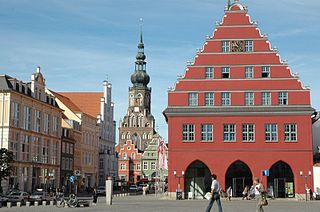
Greifswald, officially the University and Hanseatic City of Greifswald is the fourth-largest city in the German state of Mecklenburg-Western Pomerania after Rostock, Schwerin and Neubrandenburg. In 2021 it surpassed Stralsund for the first time, and became the largest city in the Pomeranian part of the state. It sits on the River Ryck, at its mouth into the Danish Wiek, a sub-bay of the Bay of Greifswald, which is itself a sub-bay of the Bay of Pomerania of the Baltic Sea.
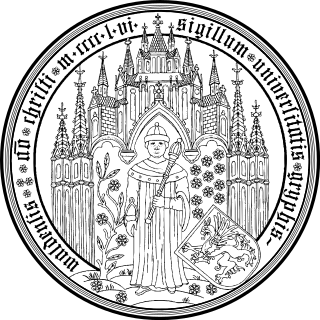
The University of Greifswald, formerly known as "Ernst-Moritz-Arndt University of Greifswald", is a public research university located in Greifswald, Germany, in the state of Mecklenburg-Western Pomerania.

Alfried Felix Alwyn Krupp von Bohlen und Halbach, often referred to as Alfried Krupp, was a German industrialist, a competitor in Olympic yacht races, contributor to the SS and a member of the Krupp family, which has been prominent in German industry since the early 19th century. He was convicted after World War II of crimes against humanity for the genocidal manner in which he operated his factories and sentenced to twelve years in prison, subsequently commuted to three years with time served in 1951.

Johan August Malmström was a Swedish painter. As an artist, he was known for his country motifs often featuring children. His most widely recognized work is Grindslanten (1885) featuring a typical scene from 19th-century Sweden. Influenced by the national romanticism of Gothicismus, he also collected motives from Norse mythology. He made illustrations for publications of both Frithiofs saga and The Tales of Ensign Stål.
The American-Scandinavian Foundation (ASF) is an American non-profit foundation dedicated to promoting international understanding through educational and cultural exchange between the United States and Denmark, Finland, Iceland, Norway, and Sweden. The Foundation's headquarters, Scandinavia House: The Nordic Center in America, is located at 58 Park Avenue, New York City.
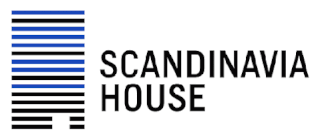
Scandinavia House – The Nordic Center in America is the American-Scandinavian Foundation's cultural center at 58 Park Avenue, in Murray Hill, Manhattan, New York City. It is dedicated to preserving the history of the Scandinavian and Nordic countries in the United States through exhibits and programming. This cultural center hosts exhibitions of fine art, design as well as performing arts pieces from Nordic countries. The center also introduces the local population and guests with Scandinavian languages and customs by organizing courses.

Swedish art refers to the visual arts produced in Sweden or by Swedish artists. Sweden has existed as a country for over 1,000 years, and for times before this, as well as many subsequent periods, Swedish art is usually considered as part of the wider Nordic art of Scandinavia. It has, especially since about 1100, been strongly influenced by wider trends in European art. After World War II, the influence of the United States strengthened substantially. Due to generous art subsidies, contemporary Swedish art has a big production per capita.

Kai Brodersen is a contemporary ancient historian and classicist on the faculty of the University of Erfurt. He has edited, and translated, both ancient works and modern classical studies. His research focuses on "Applied Sciences" in antiquity, geography, historiography, rhetoric and ancient jokes, mythography and paradoxography, Septuagint studies and Aristeas, inscriptions and curse tablets, early Greek and Hellenistic history, Roman provinces, women and men in the Ancient World, turning points of Ancient History, history of classical scholarship and reception, often with twist - plus a book for children.
Nordischer Klang is the largest festival of Nordic culture in Germany. It is a major platform for artists from Denmark, Finland, Iceland, Norway, and Sweden in Germany. The festival takes place in the town of Greifswald, which is situated about 200 km to the north of Germany's capital Berlin at the Baltic shore.

Idun was a Swedish magazine published in Sweden from 1887 to 1963. It was named after the goddess Idun, who appears with her basket of apples on its masthead.

Bertrand Freiesleben is a German artist.
Nordic art is the art made in the Nordic countries: Denmark, Faroe Islands, Finland, Iceland, Norway, Sweden, and associated territories. Scandinavian art refers to a subset of Nordic art and is art specific for the Scandinavian countries Denmark, Sweden and Norway.
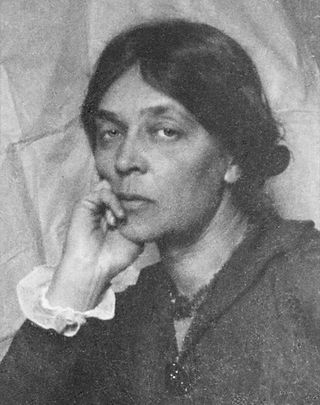
Ellen Thesleff was an expressionist Finnish painter, regarded as one of the leading Finnish modernist painters.
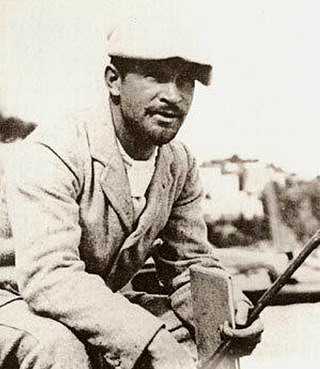
William Blair Bruce was a Canadian painter. He studied in France and became one of Canada's first impressionist painters. He lived most of his life in France and on the island of Gotland, Sweden, where he and his Swedish wife Carolina Benedicks-Bruce created the artists estate Brucebo, which was later established as a nature reserve.
Liz Magic Laser is an American visual artist working primarily in video and performance. She is based art in Brooklyn, New York.

The Apotheosis of Athanasios Diakos is an oil painting by Konstantinos Parthenis created in 1933.
Alison Aune is a painter and Full Professor of Art Education at the University of Minnesota Duluth. Her work is inspired by Scandinavian patterns and motifs. It draws on a feminist aesthetic, honoring traditional folk arts and domestic arts. Many of her patterns are based on research of Scandinavian textiles and symbols, such as the eight-pointed star. Artists such as Gustav Vigeland, Harriet Backer and Gerhard Munthe have had an important influence on her work.

The Alfried Krupp Institute for Advanced Study in Greifswald is an institute for advanced study named after Alfried Krupp von Bohlen und Halbach. On 20 June 2000, this institute was founded by the Alfried Krupp von Bohlen und Halbach Foundation, the German Land of Mecklenburg-Vorpommern and the University of Greifswald. These three founders co-established and contributed to the Stiftung Alfried Krupp Kolleg Greifswald, which was entrusted with the task of establishing this Wissenschaftskolleg. The Krupp Foundation contributed the plot of land and the building on it, valued at €15.3m, while Mecklenburg-Vorpommern and the University of Greifswald contributed the operational funding that initially amounted to €4.1m.
Leslie Anne Anderson is an American museum curator and art historian notable for her scholarship and exhibitions of nineteenth-century European, American, and regional art.
References
- 1 2 3 Indiana University: "CV Michelle Facos".
- ↑ Inc., Indigo Books & Music,. "Into the Light: The Paintings Of William Blair Bruce (1859 , 1906), Book by Tobi Bruce (Hardcover) | chapters.indigo.ca". www.chapters.indigo.ca.
- ↑ Kaldal, Ingar. "Michelle Facos: Picturing the Nordic Forest". www.kaldal.net.
- ↑ Team, UofL Web. "Lecture by Michelle Facos: Size Counts, Titles Matter". University of Louisville.
- ↑ "Homepage - GGE Summer School". ggesummerschool.
- ↑ "About Us – MooseBooties". Archived from the original on 2016-02-14. Retrieved 2016-02-02.
- ↑ "404 - Alfried Krupp Wissenschaftskolleg Greifswald" Archived 2015-04-02 at the Wayback Machine . www.wiko-greifswald.de.
- ↑ "Facos, Michelle [WorldCat.org]". www.worldcat.org.